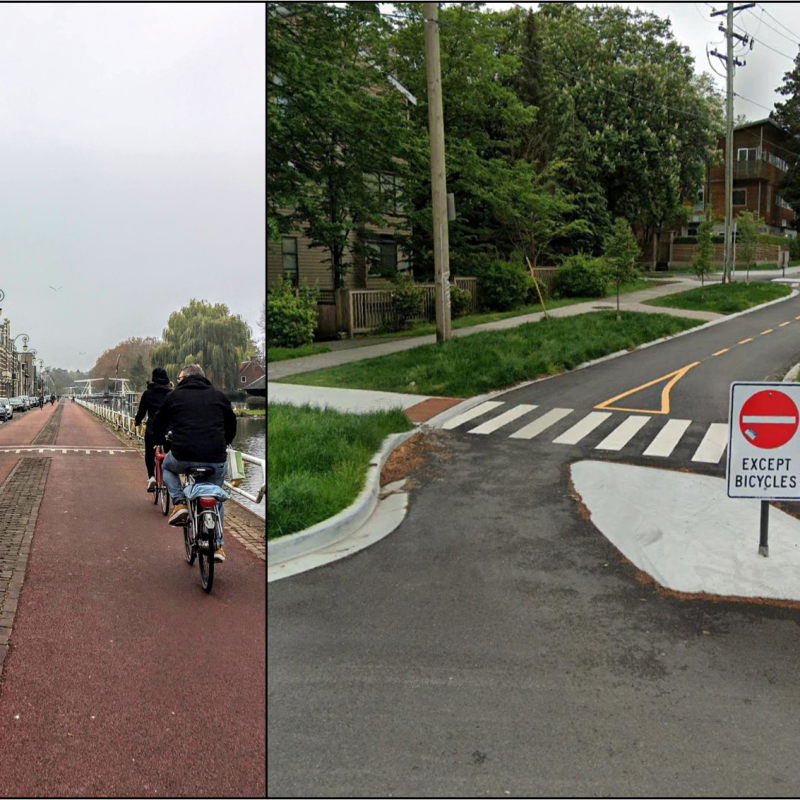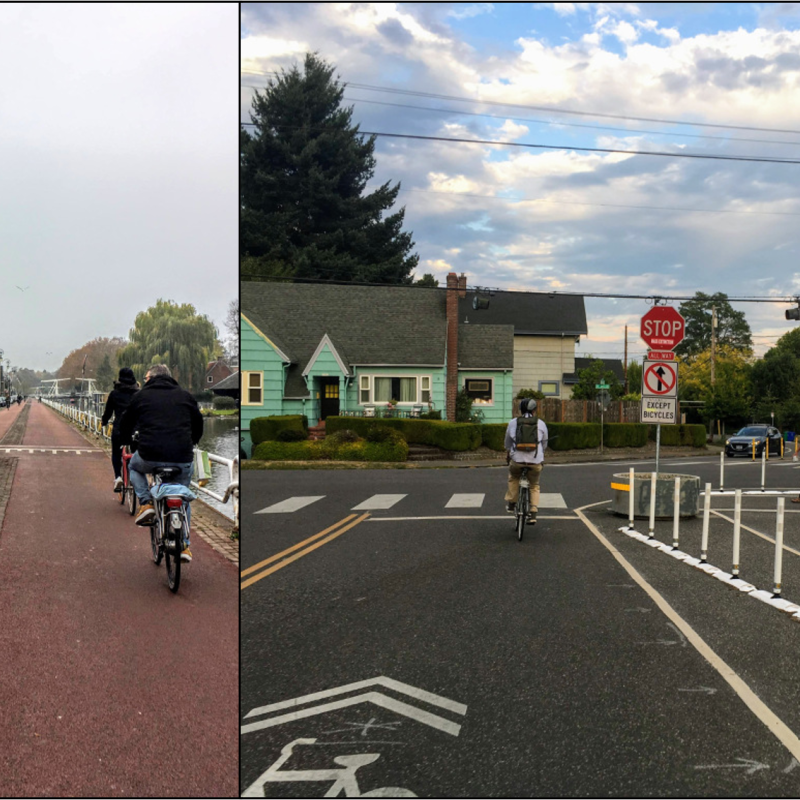Bicycle Streets Beyond Europe is a weekly multi-part series exploring the “bicycle street”. The first post overviewed the Dutch implementation of the bicycle street (“fietsstratten”) and the next several are showcasing some of the best examples of bicycle streets in Canada and the US. Special thanks to Justin Jones for contributing to this post. Join the Beyond the Automobile mailing list to stay up to date with the series.
Portland, Oregon has long been known as one of the more bike-friendly communities in the US.
Over 6% of its residents commute to work by bike and it is one of just two large cities to have the status of a “platinum” level bicycle friendly community. Portland started experimenting with bicycle-friendly neighbourhood streets in the 1980’s and has since been a pioneer of the bicycle street in the US context, which are referred to locally as Neighborhood Greenways. Its success with these even provided the foundation for NACTO’s bicycle boulevard guidance.
The City of Portland’s website best describes Neighborhood Greenways:
“Portland’s neighborhood greenways (formerly known as “bicycle boulevards”) are residential streets designed to prioritize bicycling and enhance conditions for walking. They have long represented and fostered the best elements of Portland’s transportation culture by creating safe streets where people want to bike, walk and play. To date, Portland has more than 70 miles of neighborhood greenways.”
It is clear from Portland’s description that Neighborhood Greenways are not a new or recent transportation experiment – their legacy is firmly ingrained in the city’s transportation culture. The intent to prioritize cycling is explicitly stated, and pedestrians are included as well; in fact, any street that is upgraded to a Neighborhood Greenway also receives key sidewalk accessibility upgrades, including curb ramps to make streets more navigable for people using mobility aids. This bodes well given the Dutch experience that bicycle streets work better when multiple stakeholders including local residents can benefit from the facilities. Creating a great walking experience is an excellent way to gain more buy-in from residents.
Portland makes explicit design efforts to reduce motor vehicle volumes and speeds on greenways. At select intersections, “protected crossings” and traffic diversions are used which only allow cyclists and pedestrians to continue straight, while motorists must turn right. Portland regularly monitors volumes of car traffic on greenways, and if volumes are too high in a segment, will propose more of these measures to keep volumes below their target thresholds.

Is it a Bicycle Street?
Are Portland’s Neighborhood Greenways bicycle streets? Let’s compare against the Dutch fundamentals listed in our previous post.
- Network: greenways form a 94-mile grid spanning much of the city, allowing people riding bikes to use them for both local and long-distance trips. Wayfinding signage is standardized and used throughout, and identifies key destinations and neighborhoods.
- Volumes: diversion measures are used to limit motor vehicle volumes to a target of 1,000 per day, well within the Dutch threshold. When volumes exceed 2,000 at any point it triggers an assessment for changes to reduce volumes. Though the city doesn’t require a minimum bicycle volume for greenways, many of them carry over a thousand bicycles per day. For example the SE Clinton Greenway carried over 2,500 daily bicyclists in 2018.
- Speed: the City’s stated target is an 85th percentile speed of 20 MPH (30 km/h) or less, and this is reinforced primarily with speed bumps amongst other traffic calming measures
- Design: the profile of these streets is typically quite wide, with two parking lanes and two travel lanes (around 10-11 metres [33-36 feet]), which is significantly higher than the CROW target of 4.5 metres (or 7 m with one lane of on-street parking). Sharrows are placed in the centre of the lanes to reinforce that bicyclists should be riding in the middle of the travelled area and not the edges, and where the route turns or intersects another greenway, sharrows with directional arrows help bicyclists navigate.
- Behaviour: the widespread, longstanding application and high usage of these facilities means that Portlanders have had time and opportunity to understand their purpose, and this is reflected in the behaviour of cyclists and motorists using the streets. It’s very common to see people riding together and alongside children, and motorists seem to generally accept their “guest” position on these streets.
It’s likely that Portland’s success has inspired other cities to think that the same result can be achieved with little effort; it’s quite common to see “bike routes” in other cities designed with no more than some wayfinding and sharrows. Portland demonstrates that while these features are important, they must be accompanied with the other essential ingredients: strict motor vehicle speed and volume management.
Even though they don’t visually look like a Dutch bicycle street, Portland’s Neighborhood Greenways have achieved the challenging objective of placing cyclists above motorists in the road user hierarchy, proving that local adaptations of the Dutch example can work. Their success is owed to diligent management of motor vehicle volumes and speed, a broad and connected network, and standardized wayfinding and design that allows all users to understand the unique hierarchy for these streets.

Portland’s experience also provides some meaningful lessons for other communities considering a similar type of installation. When installed on wider streets, Neighborhood Greenways are a method of providing All Ages and Abilities cycling infrastructure without the removal of resident and visitor parking. The presence of parked cars on these streets can provide traffic calming effects (as long as parking usage rates are high), and it also makes their installation a much easier political proposition. For communities thinking about ways to create a larger network of All Ages and Abilities (AAA) cycling infrastructure, the Neighborhood Greenway approach provides a cost-effective solution to the problem, repurposing and reimagining existing infrastructure in a way that benefits people on bikes, people walking and the people who live along these corridors.
Our final thought about Portland’s Neighborhood Greenways is a cautionary one. With such a well-developed system of greenways spanning the City, many people on bikes choose to avoid major streets since there is frequently a Greenway within a few blocks. The success of Neighborhood Greenways in Portland has created a situation where there is less support for physically separated bike lanes along those main streets – many of which are lined with the businesses, restaurants and local shops that people on bikes want to get to. The Dutch experience is that while bicycle streets form an important role in the creation of a safe cycling network, they cannot exclusively form the entirety, or even the majority, of an effective cycling network. They must be used in combination with protected cycling lanes, multi-use paths and cycle tracks to build a complete network of AAA cycling infrastructure. Only when all of those tools are deployed with consideration towards constructing a complete network will cycling be seen as a safe, accessible and practical choice for a majority of residents in North America.
Special thanks to Justin Jones for collaborating on this post. Justin is an active transportation and community engagement professional who works to create communities where transportation is a joy, not a chore. He works to expand access to public spaces for everyone, regardless of how they choose to get around. You can find him on Twitter.
Don’t forget to check out the other posts in the Bicycle Streets Beyond Europe series below.








3 Comments